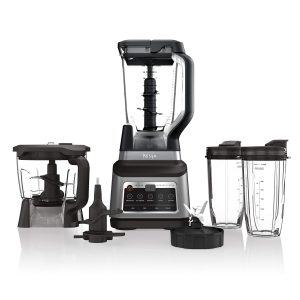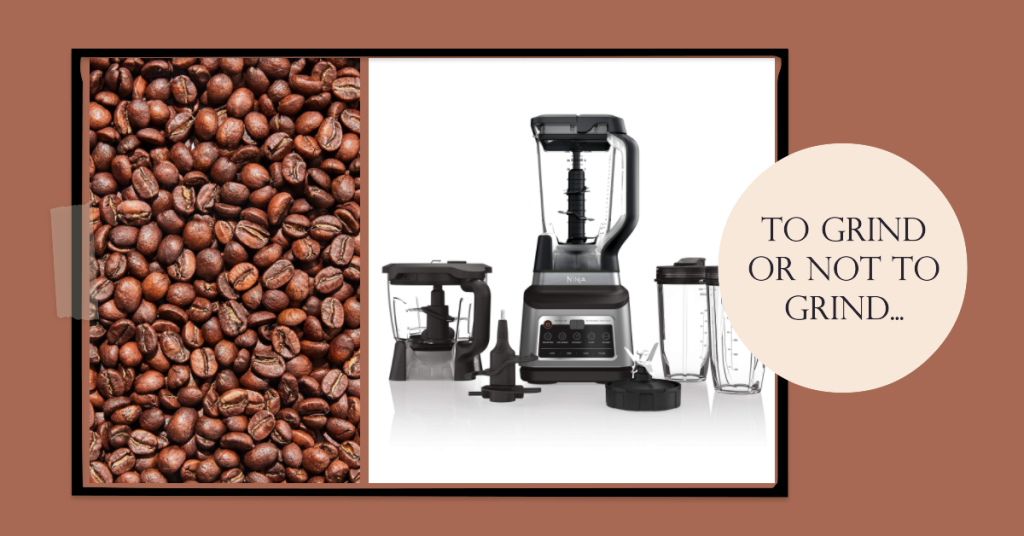Are you a coffee aficionado with a penchant for freshly ground beans? Do you own a Ninja? Have you asked yourself “Can I grind coffee beans in Ninja Blender?” The answer is YES, but we’ll go into the nuances and step-by-step directions.
Here’s a quick overview of what you’ll learn in this article:
- Getting to know the Ninja blender
- The ins and outs of grinding coffee beans in your Ninja
- The pros and cons of using a Ninja blender for coffee grinding
- Essential tips and techniques to achieve the best results
- Answers to frequently asked questions that come up when venturing into this territory
Table of Contents
Understanding the Ninja Blender

For those unacquainted, Ninja blenders are an iconic range of kitchen appliances that stormed onto the scene and captured the hearts of many. Over the years, Ninja has built a reputation for reliable, versatile, and efficient appliances that make life easier in the kitchen. They are designed to meet a wide range of culinary needs, including the need to grind coffee beans in your Ninja.
At the heart of Ninja blenders’ success are the key features they offer. Boasting high-powered motors and specialized blades, these blenders can pulverize just about anything you throw at them. While they are not primarily designed as coffee grinders, these features make them capable of achieving a reasonable grind.
There are several models of Ninja blenders available in the market, each with its unique capabilities. Some of the popular variants suitable for grinding coffee include the Ninja Professional Blender (BL610), Ninja Mega Kitchen System (BL770), and the Ninja Nutri Pro Compact Personal Blender (BL456). These models have proven to be the most effective when you decide to grind coffee beans in your Ninja. But as we’ll discuss further in this article, while possible, grinding coffee in your blender should be done thoughtfully to ensure both the quality of your coffee and the longevity of your blender.
Can You Grind Coffee Beans in a Ninja Blender?
If you’re wondering whether you can grind coffee beans in your Ninja blender, the straightforward answer is a resounding “yes.” However, just like a superhero movie, with great power comes great responsibility. As capable as your Ninja blender might be, it’s crucial to note that it was not specifically designed for this task. With that in mind, there are a few things you need to keep an eye on when repurposing your Ninja blender into a coffee grinder.
Now, how does this makeshift grinding measure up against the tried-and-true traditional coffee grinder? Let’s make no beans about it: a purpose-built coffee grinder, especially a burr grinder, tends to deliver superior consistency and control over the grind size. These attributes directly influence the taste and quality of your brew. So, while your Ninja blender can do the job, especially when you’re in a pinch, for a coffee connoisseur seeking the perfect grind, a dedicated grinder might be worth the investment.
Nonetheless, there are circumstances where grinding coffee beans in a Ninja blender makes sense. Suppose you’re someone who enjoys a cup of freshly ground coffee occasionally and doesn’t want to invest in a separate appliance. Or, you’re traveling and have limited space in your luggage. In these situations, using your trusty Ninja blender could be a great solution.
Pros and Cons of Using a Ninja Blender for Grinding Coffee Beans
As with everything in life, it’s a game of trade-offs. Using your Ninja blender to grind coffee beans has its own share of benefits and drawbacks. Let’s dive in!
Pros
- Convenience and versatility: The Ninja blender is a versatile kitchen gadget that can do much more than just blend. It can chop, mix, and yes, grind coffee beans too. This multipurpose functionality can save you both kitchen space and money.
- Economical: If you only occasionally enjoy freshly ground coffee, investing in a separate coffee grinder might not be the most cost-effective move. Using your Ninja blender can be a smart and economical solution in such scenarios.
Cons
- Lack of consistency in grind size: Unlike dedicated coffee grinders, a Ninja blender doesn’t offer a range of grind sizes. It might not deliver the same level of consistency you’d get from a specialized coffee grinder.
- Heat generation: During the grinding process, Ninja blenders can generate heat which might impact the taste and quality of the coffee.
- Potential damage to the blender: Regularly grinding coffee beans can put additional stress on the blender’s motor and blades, potentially affecting its lifespan.
If your taste buds demand the absolute best and you’ve got the countertop space, consider investing in a dedicated coffee grinder. The Baratza Encore, Capresso Infinity Plus, and OXO Brew Conical Burr Coffee Grinder are all excellent choices that offer consistency and a wide range of grind sizes for the ultimate coffee brewing experience.
Tips and Techniques for Grinding Coffee Beans in a Ninja Blender
To take your homemade brew to the next level, we’ve compiled some tips and techniques to guide you through the process of grinding coffee beans in your Ninja blender.
Let’s start by discussing the best types of coffee beans for Ninja blender grinding. While you can grind any type of coffee bean, it’s generally recommended to go for medium to dark roast beans. These are less dense and softer, making them easier to grind and less likely to damage your blender. Plus, they are known for producing a rich, robust flavor, a bonus for the coffee lovers!
Next, let’s delve into a step-by-step guide to grind coffee beans in your Ninja:
- Measure the amount of coffee beans you want to grind. A general rule of thumb is to use a 1:15 ratio of coffee to water.
- Place the beans into the Ninja blender and secure the lid.
- Pulse the blender in short bursts until you achieve the desired grind consistency. Make sure not to over-grind as the heat generated can affect the flavor of the coffee.
- Once done, remove the coffee grounds and store them in an airtight container.
To get the best results, pay attention to the type of grind and the duration of blending. For a coarse grind (ideal for French press or cold brew), blend for about 5-10 seconds. For a medium grind (perfect for drip coffee makers), you might need to blend for 10-15 seconds. Lastly, if you prefer a fine grind (best for espresso), aim for 15-20 seconds.
Remember, the secret to a perfect cup of Joe lies in the balance of these factors. Experimenting with different types of coffee beans and adjusting your blending duration can lead to discovering your unique, perfect blend.
Lastly, caring for your Ninja blender is crucial to its longevity, especially when you frequently grind coffee beans. After each use, clean the blender thoroughly to remove the oily residue left by the beans. This not only keeps your blender in top shape but also prevents the oil residue from affecting the taste of your future blends. Remember to avoid using abrasive cleaners or utensils that may scratch the blender.
With these tips and techniques in your coffee-brewing arsenal, you’re all set to grind coffee beans in your Ninja and enjoy the delightful experience of a fresh, home-brewed cup of coffee. Cheers!
Frequently Asked Questions
Got burning questions about grinding coffee beans in your Ninja blender? We’ve got you covered! Here are answers to some common queries that might be on your mind:
What is the best Ninja blender for grinding coffee beans?
While various Ninja blender models can do the job, the Ninja Professional Blender (BL610) and the Ninja Mega Kitchen System (BL770) are popular choices due to their powerful motors and durable blades.
How does the quality of coffee ground in a Ninja blender compare to that of a coffee grinder?
The quality of coffee ground in a Ninja blender might not match the precision and consistency of a dedicated coffee grinder. However, if you’re not a coffee purist and value convenience, the Ninja blender can still deliver a satisfying brew.
Can grinding coffee in a Ninja blender damage it?
Grinding coffee in your Ninja blender occasionally shouldn’t cause any significant damage. However, frequent and prolonged use can strain the motor and blades, potentially shortening the blender’s lifespan. It’s advisable to limit coffee grinding in your Ninja to occasional use.
How to clean a Ninja blender after grinding coffee beans?
Cleaning your Ninja blender after grinding coffee beans is essential to prevent any residual oils from affecting the taste of future blends. Follow these steps:
Conclusion
Grinding coffee beans in your Ninja blender can be a convenient alternative when a dedicated coffee grinder is not readily available. While it may not match the precision of a specialized grinder, the Ninja blender offers versatility and allows you to experiment with different coffee blends and grind sizes.
Remember to choose the right coffee beans, follow the recommended techniques, and be mindful of the limitations and potential impact on your Ninja blender. With proper care and occasional use, your Ninja blender can be a reliable companion in creating your own fresh, flavorful coffee.
So why not give it a whirl? Grab your Ninja blender, a bag of your favorite coffee beans, and embark on a coffee-grinding adventure that adds a delightful twist to your morning routine. Happy brewing!

